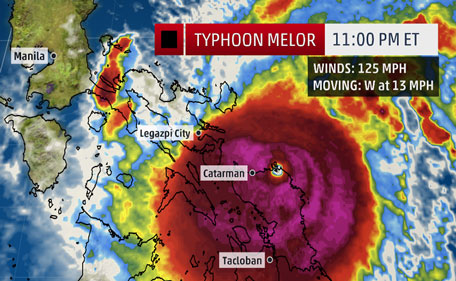Typhoon Melor strikes Philippines - Local authorities have evacuated more than 700,000 people in southern Luzon provinces as the country prepared to be deluged with torrential rain and high winds.
About Twenty provinces remain under a public storm alert, with some schools and offices ordered to temporarily close. Around 40 domestic flights have been grounded while the coast guard has stopped ferries and fishing boats from the port on Samar Island, leaving approximately 8,000 people stranded.
The storm, locally know as Nona, was expected to dump heavy rain that could cause flooding, landslides and storm surges of up to 4 meters. Typhoon Melor with maximum winds as strong as 215 kph made landfall, the equivalent of a Category 4 hurricane.
Public Storm Warning Signal 2 is in effect for provinces in the path of Typhoon Nona as far west as Batangas, to the south of Manila. The Capital city of the nation is under Storm Warning Signal 1 for winds of 30-60 kph within 24 hours.
Melor is very compact typhoon, so that will prevent its most devastating impacts from extending too far from its center,” said meteorologist Adam Douty. “While Melor will not slam onshore as a super typhoon as once feared, it still poses dangers to lives and property,” Mr. Douty added.
As of Monday afternoon, the Philippine national weather agency PAGASA said the center of Typhoon Melor was about 50 miles (85 kilometers) east of Catarman, a city along the northern coast of the island of Samar.
The typhoon was taking a similar path to the Category 5 storm Haiyan, the deadliest to hit the country in recent years. Super Typhoon Haiyan devastated the city of Tacloban in November 2013, killing almost 8,000 people. The Philippine archipelago experiences approximately 20 major typhoons every year. IMAGE/Twitter

Leave a Reply